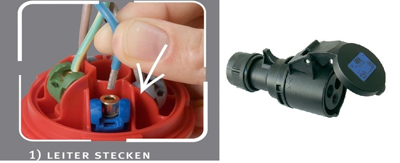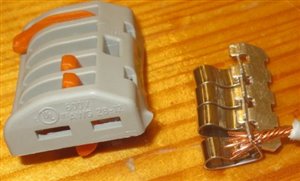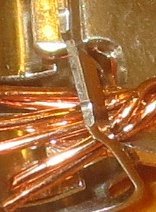mapj1:
Much better than choc bloc in any application where it may thermally cycle or shake loose - we use them a lot in vehicle/ genset settings - if you want them tidy ,they make little brackets that can be screwed to the wall of a box or clipped to a DIN rail, but it is rarely necessary.
picture here
or for the smaller bodied ones order part nr 221-500
...Having thought about this a bit more, if spring-loaded lever operated connectors are reliable and don't come loose due to thermal or vibration effects, should they not be integrated into wiring accessories instead of screwed type terminals? Also, what about MCBs? No doubt that they would need a more robust version but I could see lever operated terminals being quite convenient and safer!
Having thought about this a bit more, if spring-loaded lever operated connectors are reliable and don't come loose due to thermal or vibration effects, should they not be integrated into wiring accessories instead of screwed type terminals? Also, what about MCBs? No doubt that they would need a more robust version but I could see lever operated terminals being quite convenient and safer!
Dutch of the Elm:...Having thought about this a bit more, if spring-loaded lever operated connectors are reliable and don't come loose due to thermal or vibration effects, should they not be integrated into wiring accessories instead of screwed type terminals? Also, what about MCBs? No doubt that they would need a more robust version but I could see lever operated terminals being quite convenient and safer!




Nathaniel:
Perhaps the rather chunky nature of multiple solid-core 2.5 mm2 conductors into BS1363 sockets, with little clearance room in the back-box, is one reason for not trying quick connectors yet. When it happens, I hope it's not done following the cheapest practice. I can imagine a good design would be very convenient and could be better than trying to get three or four conductors held properly in a tunnel or cage.
Surprisingly, BS 1363 includes specifications for screwless terminals, but all I could find online was sockets with screwless face plates. Each conductor is to be clamped separately, which is pretty reasonable when you consider the difficulty that would arise if 4 mm² cable were to be looped in and out. At least three clamps would be necessary for the live conductors.
Nathaniel:
>
>
I was just going to mention that I don't remember seeing spring-loaded connectors above about 30 A, when I saw mapj1's comment and picture. Impressive.
Just for interest, I know Weidmuller also do a range of screwless terminals eg ZDU range that goes up to 35mm2 (125A) and includes a wide set of approvals including IECEx & ATEX.
We're about to take you to the IET registration website. Don't worry though, you'll be sent straight back to the community after completing the registration.
Continue to the IET registration site